Latest improvements (gen6) ZYPP
Our new models are shown on the ZYPP pages.
All our previous prototypes have been built by skilled frame builders using our own prototype jigs that fix the key parts and allow considerable positioning float on other parts while still achieving all the folding capabilities. We have fully redesigned and optimised the trike for 16in(349),18in(355) and 20in(406) wheels so customers can use the wheels that suit. We have also realigned the folding priorities. Since, for most circumstances, customers only need the fast fold we have focussed on that while still making the RAPID standard tail model quickly separable into an airline legal suitcase. The erect trike has proportions like most popular full size trikes, negating any feeling of size compromise for compact foldability, and it has a more solid look to match its capabilities.
The new ZYPP model range has a wider 75cm track to retain cornering stability with higher seats and larger wheels. It also increases the cockpit space for larger riders and slightly reduces the turning radius. All of the base models now have a 406 rear wheel and are capable of accepting all standard 135mm hub gears including Rohloffs and hub motors. All configurations have our usual super quick lean compact folding and ultra small storage footprint, and those with up to 355 front wheels still have single airline legal suitcase capability. Configurations with 406 front wheels require a marginally oversize suitcase. The base models include the “RAPID” with an improved 406 standard tail with a short fold option for extra tight spaces. This model can also accept up to a 26in or 700c rear wheel if desired; the easy entry and exit “EZY” mesh seat 406 all round model; and our signature smart car capable “SMART” folder now with a 406 smart fold tail.
Subsequent to the previous production, feedback from customers and dealers convinced us we had to be more involved with the manufacturing methods for production to ensure that decisions weren’t made that compromised the foldability and other issues. So we have turned our development skills to developing new simplified fabrication methods. We have also adjusted and finessed the design detail to make it more easily manufacturable at lower cost. Because we know what is critical, we have been able to develop methods that significantly improve manufacturability without compromises, e.g. the most challenging assembly was the fore and aft arms of the frame crucifix, including hinge parts. We experimented with various methods with local companies, which yielded good results. Finally we fabricated the fore and aft crucifix arms from low cost parts in a single welding fixture without using a skilled frame builder. (see image below) This method still delivers the accuracy required for precision folding but at a very affordable price.
Tech Guides
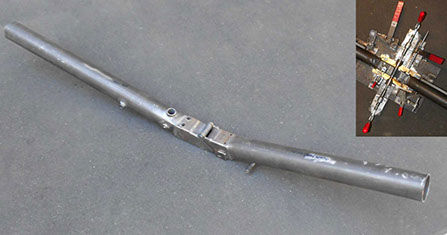
We already have a fixture that fabricates both the left and right crucifix arms reliably to the required accuracy. And we have developed a new method for reliably making the smart (twist) tail which had been a major issue with the e2. We have also made many minor improvements such as a more positive smart-fold catch and a new commercial folded seat arm catch.
"The TECH"-Design Features
*Several unique patented and patent pending folding mechanisms.
*Compact hinges allow sleek performance geometry, low CofG, efficient chain line & single pulley drive.
*A mutually reinforcing compound hinge folds the cross-members, boom and also locks the seat. Mutual hinge reinforcement maximises strength, minimises size and weight.
*Rider weight and pedalling force naturally close all hinges for added security.
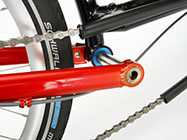


.jpg)
*Folded sizes achieved using standard cranks, pedals, gears etc.
*Modular frame can allow alternative forms for different uses.
*The folding geometry produces neat folded forms very suitable for suitcase or duffle bag.
*Compact size and shape can allow cheap air travel.
*Staged folding allows folding the trike only as much as you need to, and usually the first fold is enough.

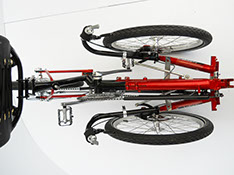
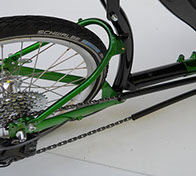
Our standard suitcase folders use super-strong 349 (16in) wheels so prominent in the Australian Pedal Prix trike racing scene.
DEVELOPMENT
We have developed and tested folding mechanisms that allow folding of a tadpole trike comparable to the best folding bikes. Our mechanisms create trikes that have convenient and compact one-piece folded forms that allow quick folding, easy fit even in a smart car, easy wheeling through narrow access ways and easy storage in a footprint little more than a person standing. They make mixed mode commuting easy.
It has taken years of innovation, development and proving, to achieve designs that are robust, reliable, super-compact, convenient and inherently safe. The joints close under rider weight and pedal force. Our design includes simple easy folding of the cross-members using a self-reinforcing compound hinge that also provides the rigidity missing on previous folding cross-member trikes. The closed joint is as rigid as an unhinged frame and is compact, allowing proven standard frame geometry.
We have trikes that can fold to about half the current minimum size in less time (under 6 seconds possible) and can fold one-piece into a smart car in under 13 seconds total. Those folds will fit in a soft airline bag, or they can fit an oversize suitcase in about 18seconds with just the rear wheel removed, or a standard 62in/158cm suitcase separated in a few minutes. And they have secure comfortable handling even above 50mph.
We think the biggest new benefit of our trikes is the convenience, of which folded size is just one part. The convenience of easy folding, being able to store one anywhere, to easily roll (not carry) the trike between any home and car, and fit one or more in virtually any car with a one piece fold in under 20 seconds. Getting to a bike path safely and conveniently is a big issue for many current and potential trike riders.
Trikes with Evolve Folding Technology provide the ultimate travelling experience and convenience.
Where can an Evolve folding trike take you?
PROTOTYPE DEVELOPMENT PROCESS
Our engineering approach is that the trike's strength and durability should be verified at each step and certainly before any customer receives one. To that end, we believe we have one of the most thoroughly pre-tested trike designs of any trike. From the very beginning of our trike development we have been improving our trikes and folding frame design through extensive testing. We have completed many years of frequent folding and unfolding, and folding to take the trikes on trains, planes, buses and cars to identify where improvements could be made. To test the durability of our designs we have taken the trikes through thousands of miles deliberately rough riding the trikes over bumps, jumps, kerbs and potholes. We have ridden them through sand, mud, corrugated roads and on snow. The current prototype is a generation 5 prototype.
Below is gen3 trike on snow.

To further verify the strength of the folding frame, the following are some examples of the extra tests we have done.
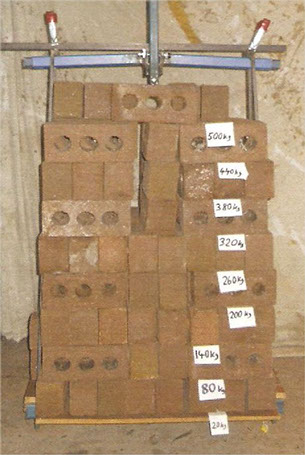
The left image shows our original successful static load test of an early (gen 2) prototype compound hinge using 144 bricks weighing 501kg (1100lb or over half ton). The hinge is designed to be stronger than the frame it is in, but for this test we used super thick cross-members to ensure they didn’t fail. There was something satisfying, even if inefficient, about loading that prototype hinge using real bricks. We chose to test to over 4 times the designed rider weight of 120kg to emulate peak forces expected from impacts like hitting a kerb, or deep potholes.
As well as extensive on-road testing we have subjected our frames and folding mechanisms to objective, repeatable tests we have adapted from the more holistic frame fatigue tests in EU standards for road, mountain and city and trekking bikes (14781, 14766 and 14764). Although these standards do not apply to recumbents we think some of the tests are very translatable to representative real-world frame durability tests for recumbents.

Pedal force frame fatigue test.
This image shows a “gen4” prototype in an early version test rig after successfully completing testing with no failures (additionally verified using dye penetrant crack detection methods) when we stopped at 110,000 cycles each pedal. We emulated pushing from the hips to the pedals cycling between zero and 130kg (287 lb) per pedal alternating between pedals. (EU Standards max 122kg pedal force, 100,000 cycles)
This setup tested the frame, hinges, seat mounts, and the resultant chain tension verified the idler pulley mount and frame tail side flex, all points of failure in other trikes. We did have to replace commercial bottom bracket components that failed.
A video of this test can be viewed on the Videos page.


a dye penetrant frame join check
Road bump frame fatigue testing. (structural integrity)
Again, this image shows one of our “gen 4” prototypes after successfully completing over 100,000 cycles of Road bump frame fatigue testing with an emulated 122kg (269lb) rider, with the weight distributed as it naturally would across the seat, pedals, handlebars. The suspension on this frame was disabled and at the high tire pressures and speed we test the wheels are airborne at each bump, also creating more than 100,000 landings.
This test fatigue verified the frame, hinge, seat mounts, handlebar mounts, and the complete fiberglass seat. Although this test is harsh, and the strength of the gen 4 cross-members was quite adequate, we have increased their rigidity in the gen5 design, reducing handlebar movement.
A video of this test can be viewed on the Videos page.
Recent Improvements to the Trikes (gen 5)
Attending the 2011 Recumbent Cycle Convention was valuable for us. Since the debut of our concept trikes at RCC we have listened to those that rode the trikes there and the input from those contributing through our email list. We then settled on the core design with the initial models being kept as simple as possible whilst maximizing adaptability for individual needs. The trikes will be compatible with a wide range of different options and many after market upgrades, including a full gamut of drive-train systems. This process was time consuming but worthwhile as we want to deliver a product that customers remain happy with for many years.
The gen 5 prototype trikes include:
- Updated geometry delivering improved handling
- Adjustable seat for rider comfort
- Modularity for future adaptation for 16” and 20” wheels with disc or drum brakes.
- Larger cross-members and headset bearing kingpins for improved ride and response
- Improved handlebar positioning and adjustability
- An automatic chain length adjuster option that stays on with the fold.
- Improved fender brackets
- And a number of smaller improvements for things like folding
- All this has been achieved without adversely affecting folding ease or speed, or the folded size of the trikes. The 16in still folds into a standard suitcase – and is now even quicker.
Through extensive trials we have optimised the trike geometry for best handling. Test riders are finding the trikes have very comfortable handling even over 50mph. We have all but eliminated brake steer from the trikes, keeping just a little on the 16in to allow higher skilled riders to use the brakes to assist fast cornering.
We’ve also increased overall frame stiffness. More than one highly experienced trike rider has commented that our compact folding frame is now stiffer than the frames of some non-folding upmarket trikes. Below is a gen5 prototype.

We have tested many options including motors. A hub motor was used to assist with frequent hill climbing between high-speed downhill test runs. It fits within the existing folded size envelope. The inherent ability of our trikes to easily roll on the 3 wheels when folded is even more beneficial with the increased weight of motor and battery. Having a ramp for the car can totally avoid the need to lift the trike when putting it in a car. Below are images of a prototype with a hub motor and silver experimental prototype with a NuVinci N360 hub and electric motor. The next image is a hard-tail trike set up with 16in front and 700c size rear wheel.





Evolve IP Pty.Ltd. ABN 93 529 316 785
US Patent 8342555, US and Intl. Patents Pending